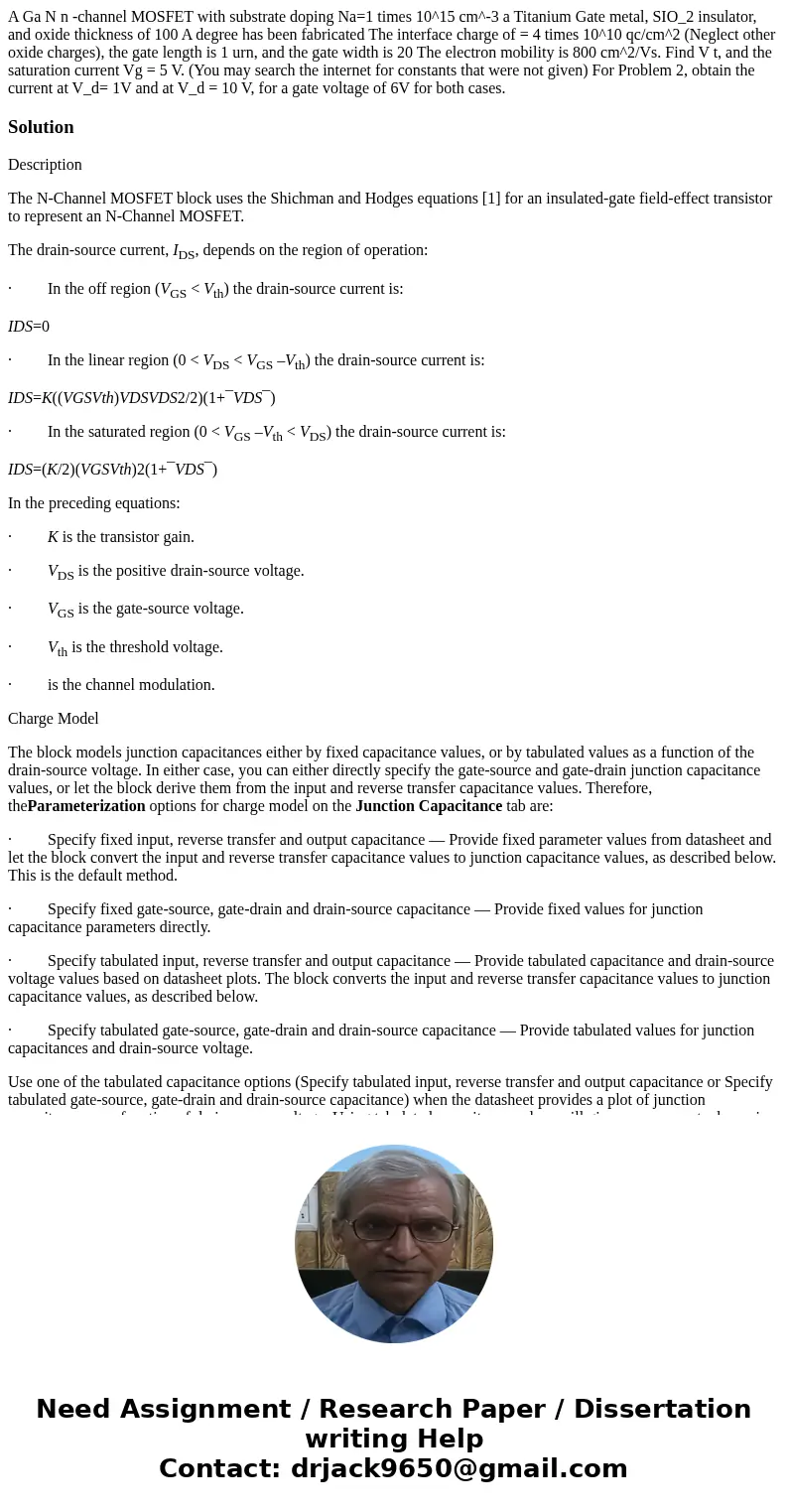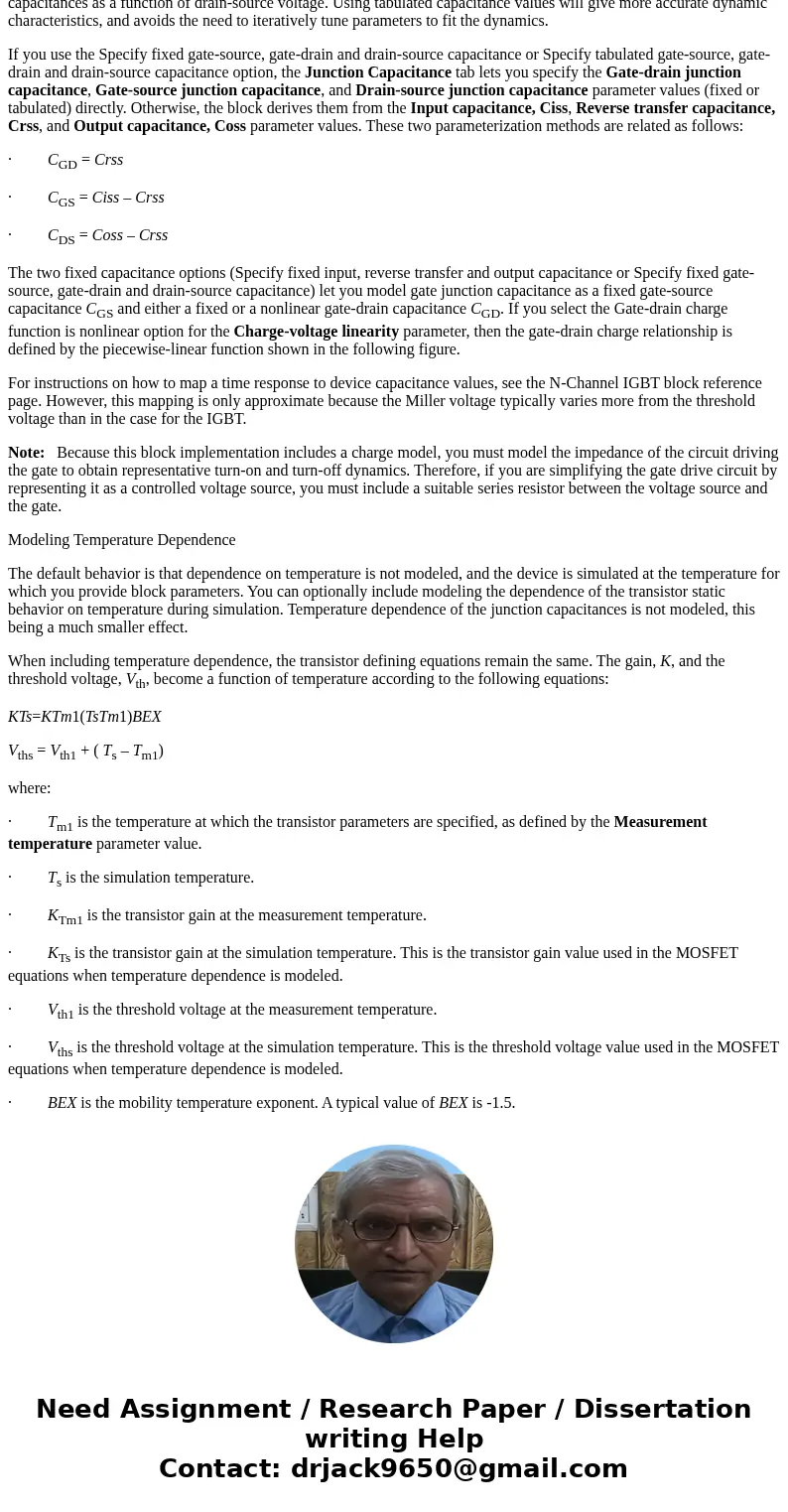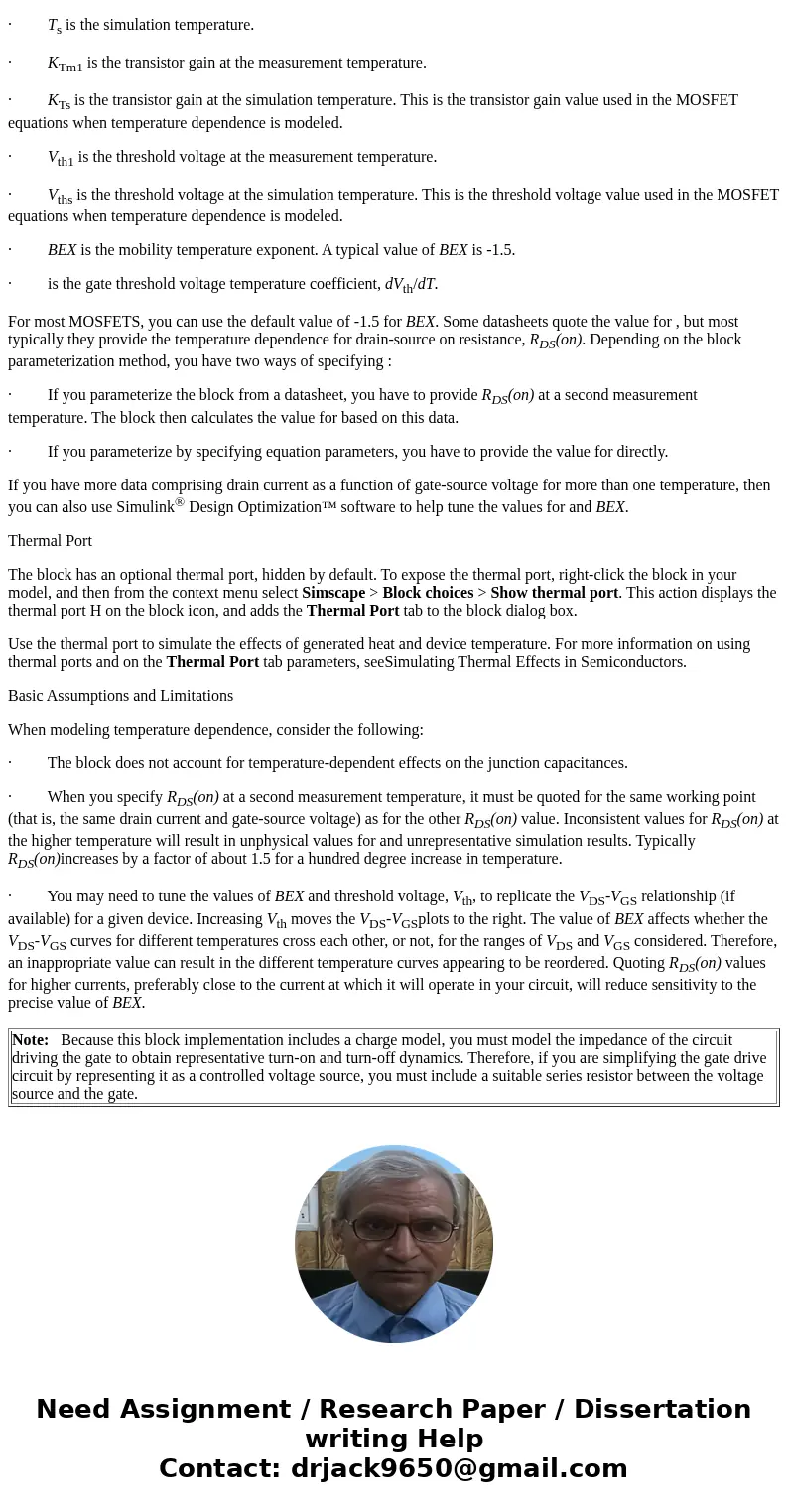A Ga N n channel MOSFET with substrate doping Na1 times 1015
Solution
Description
The N-Channel MOSFET block uses the Shichman and Hodges equations [1] for an insulated-gate field-effect transistor to represent an N-Channel MOSFET.
The drain-source current, IDS, depends on the region of operation:
· In the off region (VGS < Vth) the drain-source current is:
IDS=0
· In the linear region (0 < VDS < VGS –Vth) the drain-source current is:
IDS=K((VGSVth)VDSVDS2/2)(1+¯VDS¯)
· In the saturated region (0 < VGS –Vth < VDS) the drain-source current is:
IDS=(K/2)(VGSVth)2(1+¯VDS¯)
In the preceding equations:
· K is the transistor gain.
· VDS is the positive drain-source voltage.
· VGS is the gate-source voltage.
· Vth is the threshold voltage.
· is the channel modulation.
Charge Model
The block models junction capacitances either by fixed capacitance values, or by tabulated values as a function of the drain-source voltage. In either case, you can either directly specify the gate-source and gate-drain junction capacitance values, or let the block derive them from the input and reverse transfer capacitance values. Therefore, theParameterization options for charge model on the Junction Capacitance tab are:
· Specify fixed input, reverse transfer and output capacitance — Provide fixed parameter values from datasheet and let the block convert the input and reverse transfer capacitance values to junction capacitance values, as described below. This is the default method.
· Specify fixed gate-source, gate-drain and drain-source capacitance — Provide fixed values for junction capacitance parameters directly.
· Specify tabulated input, reverse transfer and output capacitance — Provide tabulated capacitance and drain-source voltage values based on datasheet plots. The block converts the input and reverse transfer capacitance values to junction capacitance values, as described below.
· Specify tabulated gate-source, gate-drain and drain-source capacitance — Provide tabulated values for junction capacitances and drain-source voltage.
Use one of the tabulated capacitance options (Specify tabulated input, reverse transfer and output capacitance or Specify tabulated gate-source, gate-drain and drain-source capacitance) when the datasheet provides a plot of junction capacitances as a function of drain-source voltage. Using tabulated capacitance values will give more accurate dynamic characteristics, and avoids the need to iteratively tune parameters to fit the dynamics.
If you use the Specify fixed gate-source, gate-drain and drain-source capacitance or Specify tabulated gate-source, gate-drain and drain-source capacitance option, the Junction Capacitance tab lets you specify the Gate-drain junction capacitance, Gate-source junction capacitance, and Drain-source junction capacitance parameter values (fixed or tabulated) directly. Otherwise, the block derives them from the Input capacitance, Ciss, Reverse transfer capacitance, Crss, and Output capacitance, Coss parameter values. These two parameterization methods are related as follows:
· CGD = Crss
· CGS = Ciss – Crss
· CDS = Coss – Crss
The two fixed capacitance options (Specify fixed input, reverse transfer and output capacitance or Specify fixed gate-source, gate-drain and drain-source capacitance) let you model gate junction capacitance as a fixed gate-source capacitance CGS and either a fixed or a nonlinear gate-drain capacitance CGD. If you select the Gate-drain charge function is nonlinear option for the Charge-voltage linearity parameter, then the gate-drain charge relationship is defined by the piecewise-linear function shown in the following figure.
For instructions on how to map a time response to device capacitance values, see the N-Channel IGBT block reference page. However, this mapping is only approximate because the Miller voltage typically varies more from the threshold voltage than in the case for the IGBT.
Note: Because this block implementation includes a charge model, you must model the impedance of the circuit driving the gate to obtain representative turn-on and turn-off dynamics. Therefore, if you are simplifying the gate drive circuit by representing it as a controlled voltage source, you must include a suitable series resistor between the voltage source and the gate.
Modeling Temperature Dependence
The default behavior is that dependence on temperature is not modeled, and the device is simulated at the temperature for which you provide block parameters. You can optionally include modeling the dependence of the transistor static behavior on temperature during simulation. Temperature dependence of the junction capacitances is not modeled, this being a much smaller effect.
When including temperature dependence, the transistor defining equations remain the same. The gain, K, and the threshold voltage, Vth, become a function of temperature according to the following equations:
KTs=KTm1(TsTm1)BEX
Vths = Vth1 + ( Ts – Tm1)
where:
· Tm1 is the temperature at which the transistor parameters are specified, as defined by the Measurement temperature parameter value.
· Ts is the simulation temperature.
· KTm1 is the transistor gain at the measurement temperature.
· KTs is the transistor gain at the simulation temperature. This is the transistor gain value used in the MOSFET equations when temperature dependence is modeled.
· Vth1 is the threshold voltage at the measurement temperature.
· Vths is the threshold voltage at the simulation temperature. This is the threshold voltage value used in the MOSFET equations when temperature dependence is modeled.
· BEX is the mobility temperature exponent. A typical value of BEX is -1.5.
· is the gate threshold voltage temperature coefficient, dVth/dT.
For most MOSFETS, you can use the default value of -1.5 for BEX. Some datasheets quote the value for , but most typically they provide the temperature dependence for drain-source on resistance, RDS(on). Depending on the block parameterization method, you have two ways of specifying :
· If you parameterize the block from a datasheet, you have to provide RDS(on) at a second measurement temperature. The block then calculates the value for based on this data.
· If you parameterize by specifying equation parameters, you have to provide the value for directly.
If you have more data comprising drain current as a function of gate-source voltage for more than one temperature, then you can also use Simulink® Design Optimization™ software to help tune the values for and BEX.
Thermal Port
The block has an optional thermal port, hidden by default. To expose the thermal port, right-click the block in your model, and then from the context menu select Simscape > Block choices > Show thermal port. This action displays the thermal port H on the block icon, and adds the Thermal Port tab to the block dialog box.
Use the thermal port to simulate the effects of generated heat and device temperature. For more information on using thermal ports and on the Thermal Port tab parameters, seeSimulating Thermal Effects in Semiconductors.
Basic Assumptions and Limitations
When modeling temperature dependence, consider the following:
· The block does not account for temperature-dependent effects on the junction capacitances.
· When you specify RDS(on) at a second measurement temperature, it must be quoted for the same working point (that is, the same drain current and gate-source voltage) as for the other RDS(on) value. Inconsistent values for RDS(on) at the higher temperature will result in unphysical values for and unrepresentative simulation results. Typically RDS(on)increases by a factor of about 1.5 for a hundred degree increase in temperature.
· You may need to tune the values of BEX and threshold voltage, Vth, to replicate the VDS-VGS relationship (if available) for a given device. Increasing Vth moves the VDS-VGSplots to the right. The value of BEX affects whether the VDS-VGS curves for different temperatures cross each other, or not, for the ranges of VDS and VGS considered. Therefore, an inappropriate value can result in the different temperature curves appearing to be reordered. Quoting RDS(on) values for higher currents, preferably close to the current at which it will operate in your circuit, will reduce sensitivity to the precise value of BEX.
| Note: Because this block implementation includes a charge model, you must model the impedance of the circuit driving the gate to obtain representative turn-on and turn-off dynamics. Therefore, if you are simplifying the gate drive circuit by representing it as a controlled voltage source, you must include a suitable series resistor between the voltage source and the gate. |



 Homework Sourse
Homework Sourse